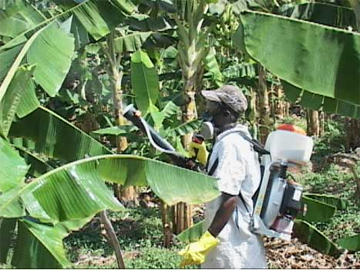The Ministry of Agriculture’s Musa Disease Management Unit has commenced an intensified spraying exercise to deal with a disease affecting banana and plantain farms located at Zeelugt West and Tuschen Backdam in Region Three.

During an outreach exercise farmers in that region recently raised concerns with Minister of Agriculture Robert Persaud about suspected Sigatoka Disease affecting their banana and plantain crop.
The minister has since instructed that a precautionary spraying programme be undertaken to protect banana and plantain farms from the disease but it is still not clear whether it is indeed the Sigatoka disease since a sample was sent to the KABI Bio-science libratory in the United States for further analysis, the Government Information Agency (GINA) reported on Friday.
The MUSA Unit which has been established with the ministry’s research arm, the National Agricultural Research Institute, has also undertaken an aggressive sensitization programme in banana and plantain growing regions.
Its activities include disease identification and assessment within the country, disease management strategies, training of staff and farmers, public awareness and sensitization, establishment of demonstration plots, and a spray programme to support farmers.
Head of the Musa Disease Management Unit, Rajendra Persaud who headed the field exercise said that it was aimed at encouraging farmers to embark on the programme which will help reduce the spread of the disease.
He noted that before farmers benefit, a sanitation exercise is required which entails a comprehensive clearing and cleaning of farmland by cutting all affected leaves and disposing of them in a proper manner since re-infection is likely.
Meanwhile, the Wilson brothers and Region Three were the first to benefit from the exercise. So far 7.5 acres of farmlands have already been completed, and according to Persaud, the remaining 7.5 acres would have been completed by the end of last week.
Research conducted by officials of NARI’s disease control unit has shown that banana and plantain crops in Regions 4, 5, 6 and 10 are not prone to the disease while Regions 2 and 3 are more susceptible, GINA reported.
There are currently two types of Sigatoka disease (yellow and black). The Sigatoka is a leaf disease that is caused by a fungus (Mycosphaerella musicola, Leach).
The symptoms of the disease appear on the leaves and not on other parts of the plant. The disease is found in almost all banana growing countries in the Caribbean region.
Some of the symptoms of the disease are pale yellow specks on the upper leaf surface, spots appearing on the 4th and 5th leaf of untreated plants and streaks appearing along the margins and apex of the leaf.
These symptoms, if untreated, cause damage to leaves making them non-functional, as well as smaller and lighter fruits, and an increase in the level of rejected fruit and an eventual death of plants.
The disease is spread naturally by wind, water splash, insects, animals and human practices, GINA added.
The spraying comes in the wake of a news item in the January 16, 2010 edition of SN where Region Three farmers lamented heavy losses from the diseased plants.
According to the farmers in the area, many of whom cultivate plantains, the disease was first observed on their farms late 2008 but at the time many of them could not determine what was causing their plants to die. They said that they were referring to the disease as “the dry leaf disease,” but it was only after they were provided with technical information by persons within the agriculture sector, whom they chose not to name, that they were informed about the source of their troubles.
The farmers, who spoke to Stabroek News also wanted their names to be withheld for fear of victimisation. They are of the opinion that the plantain industry will soon be a thing of the past. According to them, although they have invested a tremendous amount of time and money on their farms over the years, they are not reaping the benefits because of the disease.
One farmer explained that there are several stages which he has to follow when farming and these include weeding the land, placing the grass in heaps, and burning before actually planting the plantain stalks into the earth. This entire process, he stated, costs over $20,000 per an acre.
At the Rosanante Co-op Society farmlands, several acres of plantain trees lay on the ground while some which were only recently infected with the disease stood on their stalks.
The plantain trees on one person’s farm were at nine-months and, according to the farmer, he lost the entire crop. He took Stabroek News through his entire field of plantain trees, many of which lay on the ground.
He recalled that some two years ago, he observed that the colour of the leaves on his plantain trees began to change from green to a “yellowish” colour. He said he started to cut off the affected leaves but he soon observed that after the plants reached a mature stage, between eight and nine months, their leaves would “dry–up” and the plant stalk would eventually “bend in half,” even with small bunches of plantain attached.
